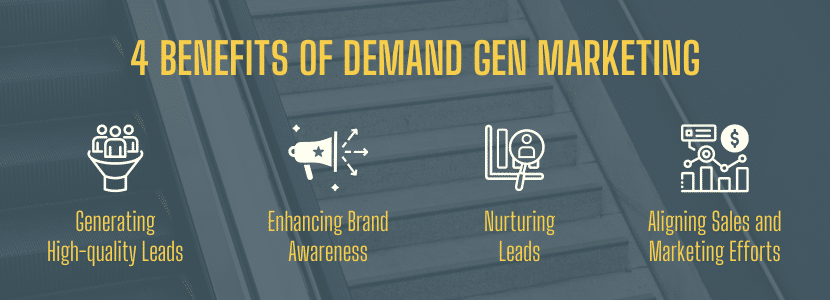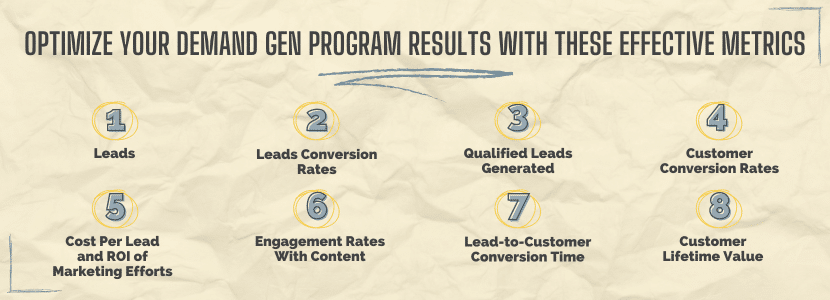Demand generation marketing, often referred to as demand gen marketing, is a strategic approach that aims to create and foster awareness and interest in your products or services. By focusing on tactics that target your ideal customers and create a genuine need for your offerings, demand gen marketing helps you generate high-quality leads that can turn into paying customers.
Demand generation marketing is essential for any business, as it helps in creating demand for your products and services, ultimately driving growth and revenue. It bridges the gap between brand awareness and lead generation, ensuring a continuous flow of qualified potential leads that can be nurtured through the sales funnel.
In this article, we’ll explore the benefits and possible disadvantages of a demand generation marketing campaign, how to measure its success, and how to choose a digital marketing agency for your demand generation campaign.
What are the goals of demand gen marketing?
Demand generation is the process of creating awareness and interest in your business’s products or services. It encompasses a wide range of marketing activities, including content marketing, social media marketing, email marketing, and more, to capture the attention of potential customers and nurture them into becoming paying customers.
The primary goal of demand generation marketing is to generate and nurture qualified leads, driving them toward conversion and ultimately increasing your business’s revenue.
It involves creating interest in and demand for your products or services by using various marketing tactics to attract and engage your target audience.
A secondary goal is to educate prospects and create brand recognition, laying a strong foundation for future customer relationships.
How demand gen marketing is different from traditional marketing
While traditional marketing typically focuses on promoting your products or services and driving short-term sales, demand gen marketing emphasizes creating long-term customer relationships.
It seeks to create an ongoing dialogue with potential customers, providing valuable content, and nurturing them through the buyer’s journey, ultimately leading to conversions.
Demand gen marketing and traditional marketing have different objectives. Traditional marketing aims to generate immediate sales, while demand gen marketing focuses on long-term customer relationships and building a sustainable pipeline of leads.
Another way of saying this is that demand gen marketing nurtures prospects, guiding them through the buyer’s journey, while traditional marketing prioritizes transactions without emphasizing customer retention or growth.
Targeting strategies in demand gen marketing are also more precise compared to traditional marketing. For example, traditional marketing uses mass marketing tactics, whereas demand gen marketing relies on data-driven strategies to target specific audience segments.
Demand gen marketing employs buyer personas, market research, and data analysis to create personalized campaigns that foster strong connections with prospects.
Demand gen marketing also emphasizes providing useful content and experiences, building trust and credibility instead of just pushing sales.
This content-driven approach positions businesses as thought leaders, creating a compelling brand image.
Additionally, demand gen marketing focuses on measuring campaign effectiveness and adjusting strategies based on data. This data-driven approach enables marketers to optimize efforts for maximum ROI, while traditional marketing often needs granular tracking and adaptability.
Understanding the benefits of demand gen marketing
The benefits of demand gen marketing include:

Generating high-quality leads
A primary benefit of demand generation marketing is its focus on generating high-quality leads that can have a lasting impact on your business.
By identifying your ideal customers and developing targeted content that addresses their specific needs and interests, you increase the chances of attracting and engaging leads with a genuine interest in your products or services. High-quality leads are more likely to convert into paying customers, contributing to your business’s long-term success.
Moreover, these existing customers can become brand advocates, further promoting your products or services through word-of-mouth and referrals.
This targeted approach not only improves the efficiency of your marketing efforts but also ensures that your resources are utilized effectively, maximizing your return on investment (ROI), and creating a sustainable pipeline of potential customers for your business.
Enhancing brand awareness
An essential benefit of a well-executed demand generation strategy is the significant enhancement of your brand’s awareness and reputation.
By consistently creating valuable, informative, and engaging content, you position your brand as an industry expert and a trusted resource for potential customers.
This increased visibility and credibility make it easier for prospects to discover and choose your business over competitors when they are ready to make a purchase.
Moreover, a strong brand presence has a compounding effect, as satisfied customers share their experiences with others, further amplifying your brand’s reach and recognition.
As your brand becomes synonymous with quality and expertise, you can leverage this awareness to drive growth and expand into new markets.
Nurturing leads
Demand gen marketing emphasizes the importance of nurturing sales-qualified leads throughout their entire journey, from initial awareness to conversion. This approach involves developing and maintaining ongoing relationships with potential customers by offering personalized content and targeted marketing tactics tailored to their needs and interests.
Nurturing leads ensures that your brand stays top-of-mind and that prospects continue to engage with your business as they move through the sales funnel.
By guiding potential customers along the buyer’s journey and providing them with the information and support they need, you increase the likelihood of driving conversions and creating loyal, long-term customers.
This relationship-based approach not only improves the effectiveness of your marketing efforts but also helps establish a solid foundation for ongoing customer satisfaction and retention.
Aligning sales and marketing efforts
One of the key advantages of a demand generation marketing strategy is the encouragement of collaboration between the sales team and marketing team. This alignment increases the potential for a seamless transition for leads as they move through the sales process, reducing friction and increasing the likelihood of successful conversions.
When both marketing and sales teams are on the same page and working towards the same goals, they can create a more cohesive and effective strategy that optimizes each stage of the buyer’s journey. This collaboration results in improved efficiency, better use of resources, and ultimately, higher conversion rates.
Additionally, an aligned sales and marketing strategy enables more accurate forecasting, smoother handoff processes, and more effective communication between teams, leading to an overall improved customer experience and increased business success.
What is the difference between demand generation marketing and lead generation marketing?
Demand generation marketing and lead generation marketing are two interrelated, yet distinct strategies that businesses employ to drive growth. Understanding the differences between these approaches is crucial for implementing a comprehensive marketing plan that maximizes results.
Demand generation marketing focuses on creating awareness and interest in a company’s products or services among the target audience. It involves a wide range of activities designed to educate potential customers about the brand values, its offerings, and the value they provide.
Demand generation marketing strategies often include content marketing, social media marketing, webinars, and events.
By establishing the brand as an authority in the industry and nurturing relationships with potential customers, demand generation marketing creates a sustainable, long-term pipeline of leads.
Lead generation marketing, on the other hand, is a subset of demand generation marketing that concentrates on identifying and capturing prospective customers who have shown interest in a company’s products or services.
The primary objective of lead generation marketing is to generate actionable leads that can be nurtured and engaged through targeted marketing and sales efforts, eventually converting them into paying customers. Examples of some common lead generation strategies include gated content downloads, newsletter subscriptions, lead magnets, and online form submissions.
The main difference between demand generation and lead generation marketing lies in their objectives and focus. While demand generation marketing aims to create demand and build brand awareness, lead generation strategy focuses on capturing and converting specific leads for the sales team.
Despite their differences, these two strategies work hand in hand within the broader marketing funnel.
Demand generation marketing sets the stage for lead generation marketing by creating a receptive and engaged audience. Lead generation marketing then captures the interest generated by demand generation marketing efforts and turns it into actionable leads for the sales team.
Take the Stairs, a Nashville-based digital marketing agency, excels in managing both demand generation marketing and lead generation marketing strategies for businesses.
Common tactics used in demand gen marketing
Some of the most common demand gen marketing tactics include the following:
Content marketing
Content marketing is an important tactic in demand gen marketing, involving the creation and distribution of relevant and engaging content tailored to your target audience.
This content can include blog posts, ebooks, whitepapers, videos, lead magnets, infographics, case studies, and more. The objective is to educate, inform, and entertain your audience, positioning your brand as a thought leader in your industry while addressing the needs and pain points of potential customers.
High-quality content not only raises brand awareness but also helps attract and retain customers, as it encourages prospects to trust and engage with your brand. By consistently delivering useful content, you can nurture leads throughout the sales funnel and guide them toward conversion, ultimately driving business growth and customer loyalty.
Social media marketing
Social media marketing is an essential demand gen tactic, as it allows you to promote your brand and content across various platforms, such as Facebook, LinkedIn, Twitter, and Instagram.
Through targeted posts, engagement, and advertising, you can reach a wider audience, drive traffic to your website, and generate leads. By maintaining an active and consistent presence on social media, you can create meaningful connections with your audience, foster brand loyalty, and gain insights into customer preferences and behavior.
Additionally, social media marketing enables real-time communication with your target audience, allowing you to address customer concerns, gather feedback, and adapt your marketing strategy accordingly.
Email marketing
Email marketing is an effective demand gen tactic, as it enables you to nurture leads by delivering personalized, targeted content directly to your customers’ inboxes.
By segmenting your email list and tailoring content to different customer profiles, you can address the specific needs and interests of each recipient, increasing the likelihood of engagement and conversion.
Well-crafted email campaigns, including newsletters, product updates, promotions, and automated nurture sequences, help maintain an ongoing relationship with potential customers, guiding them through the sales funnel and ensuring your brand stays top-of-mind.
Email marketing also offers insights into customer behavior, allowing you to analyze open rates, click-through rates, and conversion data to refine your marketing strategy.
Paid advertising
Paid advertising, including pay-per-click (PPC) campaigns and social media ads, can be an efficient demand gen marketing tactic to drive targeted traffic and generate leads.
By leveraging platforms such as Google Ads, Facebook Ads, or LinkedIn Ads, you can create targeted campaigns that reach specific segments of your audience based on their demographics, interests, and behaviors.
This targeted approach ensures that your advertising budget is spent effectively, maximizing your return on investment and increasing the likelihood of attracting high-quality leads.
Paid advertising also offers measurable results, allowing you to track campaign performance, optimize ad creatives, and adjust bidding strategies in real-time to achieve the best possible outcomes.
Account-Based Marketing
Account-Based Marketing (ABM) as a demand generation strategy emphasizes driving demand for your products or services within specific high-value accounts. This targeted approach allows organizations to concentrate their resources on the most promising prospects.
In an account-based marketing strategy, marketing and sales teams collaborate to identify and research high-value accounts. They then create personalized content and experiences tailored to the unique needs and challenges of these accounts.
This targeted messaging showcases the value that the organization’s product or service can provide to the account, which helps build trust and nurture relationships with key decision-makers.
By using a multi-channel approach, including email, social media, paid advertising, and content marketing, organizations can engage with target accounts across various touchpoints.
ABM as a demand generation strategy not only streamlines marketing efforts but also helps align sales and marketing teams.
This alignment fosters a seamless customer journey and a more efficient handoff of leads between teams, resulting in higher conversion rates and stronger customer relationships.
Crafting a demand generation strategy that aligns with your marketing strategy

A demand generation strategy is an overarching plan that incorporates various tactics and activities, such as content creation and promotion, event marketing, lead nurturing, email campaigns, and more.
By creating cohesive demand generation strategies that define your goals and the steps needed to achieve them, you can streamline your demand generation efforts and maximize results.
To create effective demand generation strategies, follow these steps:
Identify your target audience and create detailed buyer personas
Understanding your target audience is the first step in crafting an effective demand generation strategy.
Conduct market research and gather customer feedback to develop detailed buyer personas representing your ideal customers. These personas should include information on demographics, pain points, preferences, and motivations.
By identifying your target audience, you can tailor your messaging, channels, and tactics to address their specific needs and interests.
Develop clear and measurable marketing goals
Establish specific, measurable, achievable, relevant, and time-bound (SMART) goals for your demand gen marketing efforts.
These goals will guide your strategy and help you focus on the tactics that drive the desired results. They also provide a benchmark to measure the success of your marketing initiatives and make necessary adjustments to improve performance.
Define your unique value proposition
Your unique value proposition (UVP) is what sets your business apart from your competitors and should communicate the benefits and advantages you offer to your customers.
A compelling UVP can help differentiate your brand, resonate with your target audience, and increase the likelihood of conversion. Ensure that your UVP is consistently communicated across all marketing channels and content.
Create a content strategy
Develop a content strategy that aligns with the needs and interests of your target audience, supports your marketing goals, and emphasizes your UVP.
Plan a mix of content types, such as blog posts, ebooks, videos, and webinars, to engage your audience and establish your brand as a thought leader in your industry.
Regularly update and optimize your content to maintain its relevance and effectiveness.
Utilize various marketing tactics
Implement a combination of demand gen marketing tactics, such as content marketing, social media marketing, email marketing, paid advertising, and webinars or events. By leveraging multiple tactics, you can reach your audience through various channels and touchpoints, increasing your chances of creating a reputation of expertise, and generating and nurturing leads.
Collaborate with your sales team
Align your marketing teams and sales efforts to ensure a seamless transition for leads as they move through the sales funnel. Establish clear communication and processes between the teams, such as lead scoring, handoff protocols, and shared performance metrics.
This collaboration helps to create a cohesive customer journey, ultimately resulting in higher conversion rates and stronger customer relationships.
Regularly analyze and optimize your demand gen marketing efforts
Continuously monitor the performance of your demand gen marketing initiatives using analytics tools and customer feedback.
Track metrics such as website visits, lead conversions, and engagement rates to evaluate the success of your campaigns.
Analyze your data to identify areas for improvement and make data-driven decisions to refine your strategy, optimize your tactics, and maximize the return on your marketing investment.
Measuring the impact of your demand gen program

Effectively gauging the success of your demand gen marketing program is crucial in determining the effectiveness of your strategies and making data-driven decisions for future marketing efforts. To measure the impact of your demand gen program, consider the following demand generation metrics:
Leads
To measure the volume of leads generated by your demand gen program, use customer relationship management (CRM) platforms, such as Salesforce, HubSpot, or Zoho. These tools track lead sources, helping you identify which marketing channels are the most effective in attracting prospects.
Lead conversion rates
Conversion rates are a key metric to evaluate the effectiveness of your demand gen campaigns. Google Analytics is a popular tool for tracking conversion rates, as it allows you to set up goals, monitor user behavior, and evaluate the performance of your marketing channels.
Usually, this refers to a prospective customer making the initial action.
Each company will define leads differently. E-commerce businesses will consider conversions a sale, while some influencers will consider a follow, and other businesses a meeting.
Make sure that your leadership team properly defines your conversion rates for what fits best for your business.
Qualified leads generated
Monitoring the number of qualified leads your marketing efforts produce is essential to understanding the reach and effectiveness of your demand gen program. It also helps you identify which tactics are most successful in attracting potential customers.
Before you can count your qualified leads, they must be defined. Spend time establishing honest metrics for what a qualified prospect means to your organization.
Defining a qualified lead for your business isn’t a “set it and forget it” activity either. Make sure you spend time at least annually (quarterly would be ideal) to reevaluate your criteria.
Customer conversion rates
Analyzing the percentage of leads that convert into paying customers provides insights into the efficiency of your marketing and sales processes.
A high conversion rate indicates that your demand gen strategies are successfully driving targeted, interested leads into the sales funnel.
A low conversion rate could be a sign that it’s time to aim your sales and operations with more support to better foster leads through the sales cycle. Review the sales process end to end to uncover potential opportunities for improvement.
Cost per lead and ROI of marketing efforts
Evaluating the cost of acquiring each lead (or cost per lead, CPL) and the overall ROI of your marketing initiatives is critical in determining the financial effectiveness of your demand gen program.
This information can guide budget allocation and optimization of your marketing tactics. Even more importantly, break down your cost per lead and conversion per ad platform you’re using. You might find it’s better to move your money away from some ad platforms.
Engagement rates with content
Assessing engagement metrics such as email open rates, click-through rates for ads, and social media interactions helps you understand how well your content resonates with your target audience.
High engagement rates are indicative of relevant, compelling content that captures the interest of potential customers.
Engagement is finally getting the support it deserves. Not everyone is ready to buy today but that doesn’t mean you can’t gain favor with potential customers. Work towards creating educational and entertaining content.
Lead-to-customer conversion time
The time it takes for a lead to become a customer is a valuable metric to track, as it provides insight into the efficiency of your sales process and the effectiveness of your lead-nurturing strategies.
Shorter conversion times can suggest a streamlined customer journey and an optimized demand gen program.
The longer your sales cycles, the more human interaction is likely necessary. Make sure to build your process accordingly.
Customer lifetime value
Estimating the total revenue a customer generates for your business throughout their relationship with you can help determine the long-term value of your demand gen marketing efforts.
A high customer lifetime value (LTV) indicates strong customer relationships, retention, and loyalty, which are all desirable outcomes of a successful demand gen program.
Regularly reviewing and analyzing these metrics allows you to make informed marketing decisions, optimize your demand gen strategies, and ensure your efforts remain effective and relevant in an ever-changing market landscape.
If demand gen marketing is something you’d like to explore, contact Take the Stairs for an impactful discussion
Demand gen marketing can be a game-changer for your business, offering long-term growth and increased revenue.
If you’re ready to take your marketing efforts to the next level, contact Take the Stairs today. Our experienced professionals are here to help you craft an impactful demand gen marketing strategy that delivers.
Contact us for a comprehensive discussion about your marketing needs and goals.









